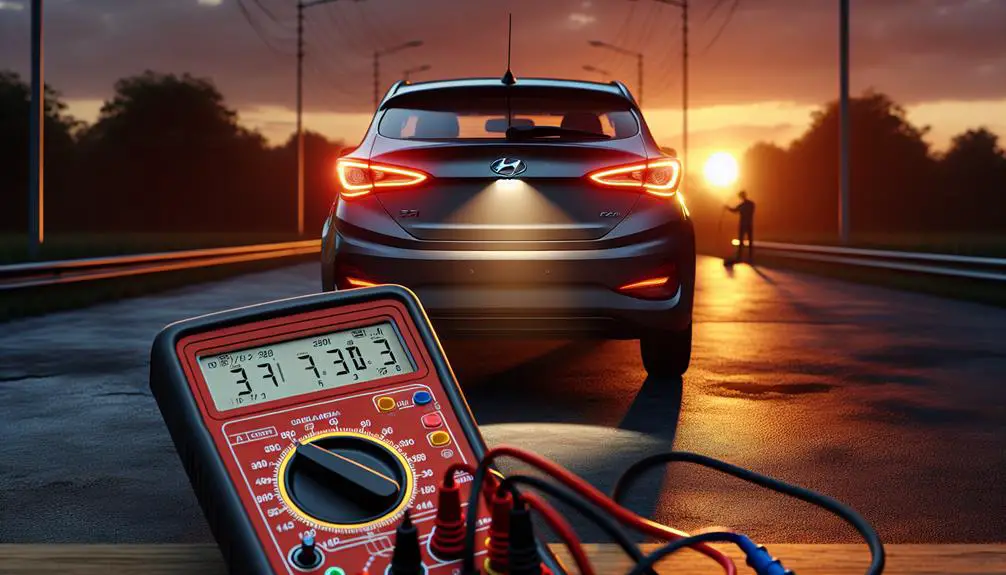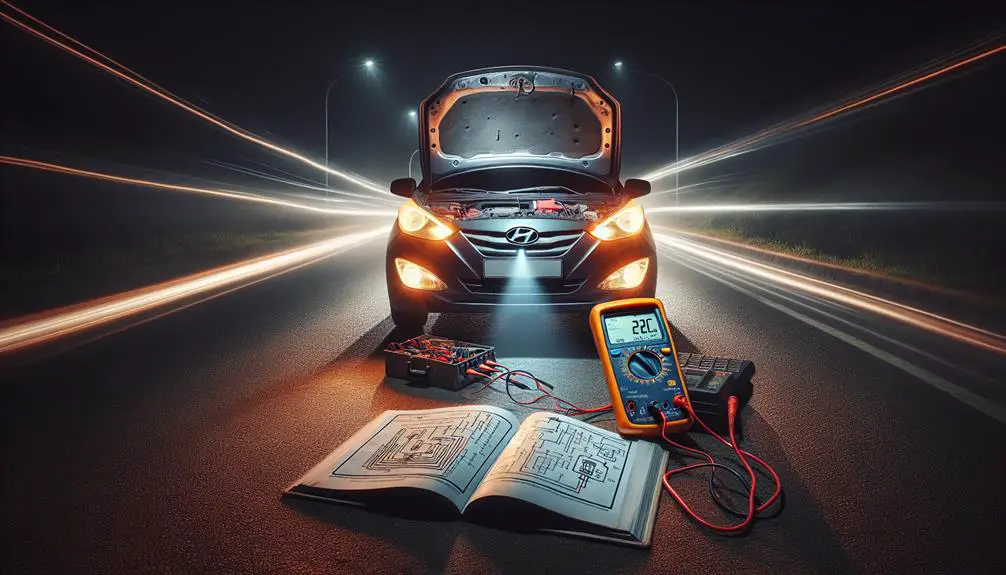Identifying the root cause of Hyundai brake lights not working is essential for resolving the issue. This can involve checking and potentially replacing any blown fuses, as well as conducting electrical troubleshooting to pinpoint the exact source of the problem.
Failure to address brake light issues promptly can compromise road safety, so it's crucial to address this problem as soon as possible.
Identifying the Problem

Why aren't your Hyundai's brake lights working? It's a question you might ask yourself when you notice that pressing the brake pedal doesn't light up the rear of your car. Identifying the problem requires a bit of troubleshooting, but don't worry; it's something you can do.
Initially, you need to check the brake light bulbs. It's common for bulbs to burn out, especially if you haven't replaced them in a while. You'll find the brake lights at the rear of your Hyundai. Remove the cover and inspect the bulbs. If they're blackened or the filament is broken, they need replacing. This is a simple fix you can do yourself with replacement bulbs from any auto parts store.
Another potential issue could be a bad brake light switch. This switch is what signals your brake lights to turn on when you press the pedal. If it's faulty, your brake lights won't work. Locating the brake light switch can be a bit tricky, as it's usually positioned near the top of the brake pedal. Checking if the switch is working properly can be done with a multimeter, but if you're not comfortable with electrical work, it might be time to call in a professional.
Don't overlook the possibility of a wiring issue. Damaged or corroded wires can interrupt the power supply to your brake lights. Inspecting the wiring requires patience and possibly removing some interior panels to trace the brake light wiring. If you find damaged wires, repairing or replacing them is vital for your brake lights to function correctly.
Checking the Fuse
Often overlooked, checking the fuse is a critical step in troubleshooting your Hyundai's brake light issues. When you're facing a situation where your brake lights aren't working, it's vital not to jump straight to complex solutions. The fuse box in your Hyundai acts as the initial line of defense, protecting electrical components from surges. If a fuse blows, the circuit it's protecting will stop working, which could be why your brake lights have gone dark.
You'll find the fuse box in a couple of places in your Hyundai: under the dashboard on the driver's side or in the engine compartment. Consult your owner's manual to locate the exact position and to identify the specific fuse associated with the brake lights. This manual should have a diagram detailing which fuse corresponds to which function.
Once you've located the brake light fuse, you'll need a fuse tester or a multimeter to check its condition. If you don't have these tools, a visual inspection might reveal if the metal wire inside the fuse is broken. However, this isn't always foolproof, as some fuses can fail without visible signs.
If you uncover the fuse is blown, replacing it's straightforward. Make sure you use a fuse of the exact same amperage to prevent electrical issues. After replacing it, test your brake lights again. If they're still not working, the problem lies elsewhere, but at least you've ruled out one of the simplest fixes. Remember, always handle electrical components with care to avoid further damage or personal injury.
Inspecting Brake Bulbs

Having ruled out a blown fuse as the cause for your Hyundai's brake light failure, it's time to examine the brake bulbs themselves. This step is important and often reveals the root of the problem. Don't worry; it's simpler than it seems at the outset.
Firstly, make sure your Hyundai is turned off and the keys are removed from the ignition. You'll be working near electrical components, so safety first. Open the trunk or access the brake light assembly from the back of your vehicle, depending on your model. You're looking for the brake light housing, which is typically easy to spot.
Once you've located the brake light housing, you'll need to remove it to access the bulbs. This usually involves unscrewing or unclipping the housing. Be gentle to avoid any damage. With the housing removed, you can now see the brake bulbs.
| Check Point | What to Look For |
|---|---|
| Bulb Condition | Look for any signs of blackening, breakage, or filament damage. |
| Connection | Make sure the bulb is securely fitted in its socket. |
| Compatibility | Verify that the bulb type matches what's recommended for your Hyundai. |
If a bulb looks damaged or worn out, it's time for a replacement. Remember, even if only one brake light is out, it's a good practice to replace them in pairs to ensure uniform lighting. Replacing brake bulbs is straightforward: carefully remove the faulty bulb, avoiding touching the new bulb's glass with your fingers, and insert the new bulb into the socket.
Inspecting and replacing brake bulbs might seem challenging, but it's a manageable task. With patience and attention to detail, you'll have your Hyundai's brake lights shining brightly again in no time.
Evaluating the Brake Light Switch
After inspecting the brake bulbs, it's crucial to evaluate the brake light switch, as it's another common culprit behind malfunctioning brake lights. This switch is typically located near the brake pedal and is responsible for activating your Hyundai's brake lights when you press the pedal. If this switch fails or is out of adjustment, your brake lights won't illuminate, posing a significant safety risk.
To effectively evaluate the brake light switch, follow these steps:
- Locate the Switch: It's usually mounted close to the top of the brake pedal. In some Hyundai models, you might need to remove a panel or cover to access it.
- Check for Physical Damage: Look for any signs of damage or corrosion on the switch itself or its connectors. Physical damage can prevent the switch from functioning correctly.
- Test the Switch: You can test the switch with a multimeter. Ensure the switch is in the 'off' position (pedal not pressed). There should be no continuity between the terminals. When the pedal is pressed, the switch should close, creating continuity. If the switch doesn't change states as described, it's likely faulty and needs replacement.
Addressing Electrical Issues

Once you've checked the brake light switch and bulbs, it's time to examine your Hyundai's electrical system for any issues that might be affecting the brake lights. Electrical problems can be a bit more complex, but don't worry, you can tackle them with a bit of patience and the right approach.
First, you'll want to look at the fuse box. Your Hyundai's manual will show you exactly where to find the brake light fuse. If it's blown, replacing it could solve your problem. Just make sure you replace it with a fuse of the same amperage to avoid any further issues.
Next, inspect the wiring leading to the brake lights. Look for any signs of wear, tear, or damage. Rodents, time, or the elements can harm these wires, causing your brake lights to fail. If you find damaged wires, you'll need to repair or replace them. For simple repairs, electrical tape might do the trick, but for more severe damage, you might need to splice in new wire sections or consult a professional.
Don't forget to check the ground connection, too. A poor ground can cause all sorts of electrical gremlins. Usually, you'll find the ground point near the tail lights. Clean any corrosion and make sure it's making a good connection.
Lastly, if you've gone through these steps and your brake lights still aren't working, it might be time to seek professional help. An auto electrician can diagnose and fix problems that are too complex for the average DIYer. Remember, your brake lights are essential for safety, so don't delay in addressing any issues you find.
Conclusion
To sum up, you've now tackled the common culprits behind your Hyundai's brake lights not working.
You've checked the fuse, inspected the brake bulbs, evaluated the brake light switch, and addressed potential electrical issues.
With these steps, you're well on your way to ensuring your brake lights function properly, enhancing your safety on the road.
Remember, if you're still facing issues, it's wise to consult a professional to avoid any risks while driving.
Stay safe and keep your Hyundai's lights in check.